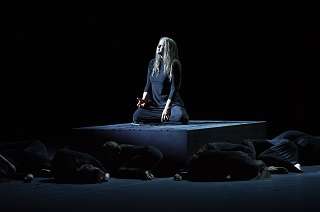|
Back
A thrilling dramatic experience Toronto
The Four Seasons Centre for the Performing Arts
09/22/2011 - and September 25, 28, October 1, 4, 7, 12, 15, 2011
Christoph Willibald Gluck: Iphigénie en Tauride
Susan Graham*/Katherine Whyte (Iphigénie), Russell Braun (Orest), Joseph Kaiser (Pylade), Mark S. Doss (Thoas), Lauren Segal (Diane), Jaqueline Woodley (First Priestess), Mireille Asselin (Second Priestess), Neil Craighead (A Scythian Man), Robert Pomakov (Old Servant), Ambur Braid (A Greek Woman)
Robert Carsen (Director, Lighting Co-design), Tobias Hoheisel (Set and Costume Design), Peter van Praet (Lighting Co-design), Philippe Giraudeau (Choreography)
Pablo Heras-Casado (Conductor), Sandra Horst (Chorus Master)
The Canadian Opera Company Orchestra and Chorus 
S. Graham (© John Currid)
Just a few months after the Canadian Opera Company’s first ever Gluck opera, Orfeo ed Euridice in an eloquent modern-minimalist production by Robert Carsen, we now have the same director’s Iphigénie en Tauride.
Toronto is fortunate in having another opera company (Opera Atelier) that has produced this opera twice in recent years. (Opera in Concert, ever the ground-breaker, did a fine job with it in 1998.) It is interesting to compare the approaches of each company: Opera Atelier, employing the Tafelmusik Baroque Orchestra, created a colourful production with their singular version of period stage deportment and dance, while the COC has brought in Carsen’s dark vision of the opera, with its use of modern dance that works so well to emphasize the primal nature of the drama.
A slate-gray box contains the action. A wraith-like figure appears from its murky depths - this turns out to be the fragile-looking Iphigénie. As for Orfeo ed Euridice, Carsen co-designed the lighting (along with Peter van Praet) which becomes THE central element of the production’s design. It allows us to see the faces of the central characters while the dancers (there are 20, although it frequently seems like more) remain in amorphous groupings, whether acting as Iphigénie’s acolytes, Thoas’s savage followers, or the furies pursuing Orest. At crucial moments the performers cast eloquent shadows.
Another potent design element: the names Agamemnon, Clytemnestre, Orest, and Iphigénie are chalked on to the set. At a crucial point Iphigénie erases her name as she seems to doubt the reality of her own existence.
The singing is of a very high order. Susan Graham seems to be the Iphigénie of choice today and now we in Toronto know why. There is absolutely no sign of routine in a role she has performed so often. The two male leads are her equal in vocal and dramatic quality. Their initial appearance is disappointingly mundane as they are dressed in ordinary black slacks and shirts and don’t look at all like shipwrecked captives. However, they quickly make up for this in their impassioned portrayals of the haunted, guilt-ridden matricide, Orest, and his ardent friend, Pylade. Russell Braun injects maximum passion into his voice but never loses steadiness or the vocal line. Joseph Kaiser (a graduate of the COC’s Ensemble Studio) projects a glowing stream of tone in his wonderful first aria “Unis dès la plus tendre enfance” and indeed throughout the performance.
Mark S. Doss explodes on to the stage as the barbaric Thoas - dramatic shifts in lighting magnify the impact of stage movements at this and many other points in the action. The smaller roles are all well sung. Something very clever was done so that the voice of the invisible goddess Diane (Lauren Segal) descends from mysterious heights.
The chorus sings from the rear of the orchestra pit (thus leaving the stage free for the dancers) - they sound just fine, as does the orchestra under Pablo Heras-Casado (who won a local award for his conducting of Nixon in China last season).
The dramatic and musical voltage is thrillingly maintained throughout the performance but there is a lessening of the dramatic tension toward the end of the opera. The goddess Diane intervenes after Pyalde has arrived to rescue Orest; she absolves him of guilt and a new day seems to open for Iphigénie as she is released from her servitude under Thoas. The stark walls lift a bit to let in some light. However, it is a very cold white light, and Orest and Pylade laconically leave the stage in separate directions, leaving Iphigénie alone once again (now surrounded by piles of corpses). With this ambiguous ending the producer obviously doesn’t want us to experience the full catharsis that classical tragedy traditionally delivers.
This opera looks forward to so many great works to follow. It is arguably the first rescue opera (Beethoven’s Fidelio appeared 26 years later). Pylade’s exit aria, sung when he vows to save Orest, looks forward to Manrico’s “Di quella pira” in Verdi’s Il trovatore. The women’s chorus serving Iphigénie are a foretaste of the great music in Berlioz’s Les Troyens (Part I). Richard Strauss prepared a performing version of this work just a few years before composing his opera on the House of Atreus, Elektra, which also features a dramatic brother-sister recognition scene. It’s wonderful to see Iphigénie en Tauride so capably performed by the COC.
Michael Johnson
|